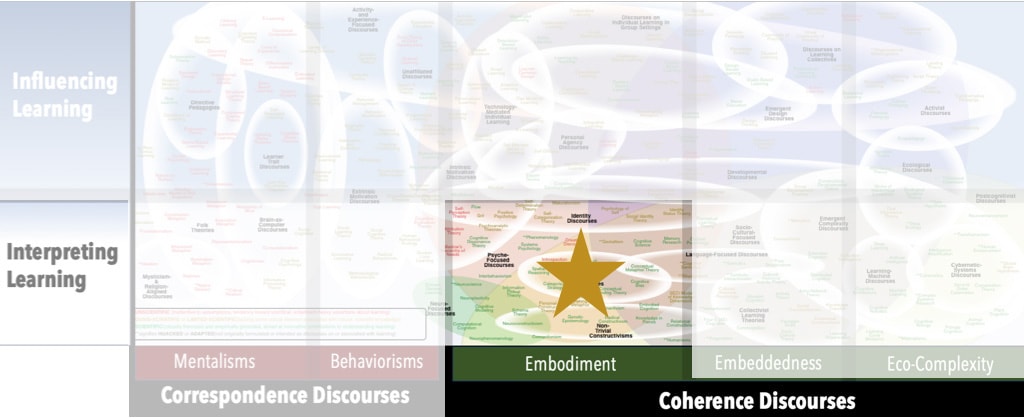Focus
Goal-oriented perseverancePrincipal Metaphors
Proponents of Grit are not explicit about interpretations of the complex dynamics of learning. While Grit belongs among Coherence Discourses, explications of the perspective tend to make extensive use of the Attainment Metaphor:- Knowledge is … scope of possible actions and interpretations
- Knowing is … staying the course
- Learner is … a striver (individual)
- Learning is … journeying
- Teaching is … guiding. orienting
Originated
2000sSynopsis
In the current educational literature, Grit refers to both a personality trait and a psychological discourse. The trait is typically described in terms of a persistence of effort and a goal-oriented passion. In psychology, the notion is associated with such concepts as hardiness, perseverance, positivity, and conscientiousness. Individuals with “high grit” remain determined, motivated, and focused over long terms, even when meeting failure and adversity. It is also strongly associated with (and sometimes equated to):- Persistence (Perseverance) (C. Robert Cloninger, 1980s) – a temperament trait associated with staying with a task until it is completed, despite obstacles and frustrations
- Resilience (Buoyancy; Coping; Hardiness; Mental Toughness; Psychological Resilience; Resiliency) – invoking the property of some materials to spring back into shape after being subjecting to distorting pressures, Resilience refers to the psychological ability to cope with and recover from crisis situations
- Grit Scale (2000s, Angela Duckworth) – a self-administered 17-item assessment of one’s Grit
- Short Grit Scale (Grit-S) (2000s, Angela Duckworth) – a self-administered 8-item assessment of one’s Grit
- Temperament and Character Inventory (C. Robert Cloninger, 1980s) – a 240-item, self-report inventory focused on four “dimensions of temperament” (persistence, harm avoidance, novelty seeking, reward dependence) and three “dimensions of character” (self-directedness, cooperativeness, self-transcendence)
- BRiTE (Building Resilience in Teacher Education) (Caroline Mansfield, 2010s) – a program aimed at educating educators on building Resilience through nurturing relationships, well-being, motivation, and mindfulness of emotions
- CARE (Cultivating Awareness and Resilience in Education) (Patricia Jennings, Christa Turksma, Richard Brown, 2010s) – a professional development program for teachers, focused on well-being, motivation, efficacy, communication, and mindfulness of emotions
- CBR (Contemplative-Based Resilience) (Sharon Salzberg, 2000s) – a program aimed at nurturing resilience, emphasizing understanding of the neurobiology and psychology of stress, mindfulness activities, and relationships
Commentary
One of the major, substantiated claims around Grit is that it’s a better predictor of academic success than IQ. However, careful analyses of research data have revealed that a single component – namely, perseverance – accounts for observed variations. Many commentators have criticized the tendency of proponents to downplay poverty, racism, poor teaching, and other conditions, thus sometimes laying blame for poor achievement at the feet of disadvantaged learners. Phrased differently, arguments have been made that an emphasis on Grit is misplaced; greater attention should be given to addressing systemic issues that compel a need to be unusually resilient.Authors and/or Prominent Influences
Angela DuckworthStatus as a Theory of Learning
Insofar as it is useful for understanding learner motivations, Grit can be interpreted as a theory of learning.Status as a Theory of Teaching
Grit is not a theory of teaching.Status as a Scientific Theory
As noted above, the empirical evidence in support of Grit can be interpreted differently from the manner forwarded by its proponents.Subdiscourses:
- BRiTE (Building Resilience in Teacher Education)
- CARE (Cultivating Awareness and Resilience in Education)
- CBR (Contemplative-Based Resilience)
- Grit Scale
- Persistence (Perseverance)
- Resilience (Buoyancy; Coping; Hardiness; Mental Toughness; Psychological Resilience; Resiliency)
- Short Grit Scale (Grit-S)
- Temperament and Character Inventory
Map Location

Please cite this article as:
Davis, B., & Francis, K. (2024). “Grit” in Discourses on Learning in Education. https://learningdiscourses.com.
⇦ Back to Map
⇦ Back to List
